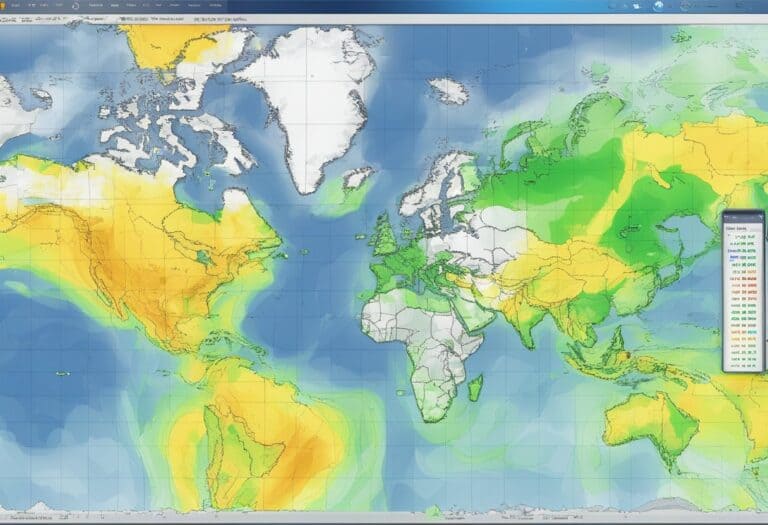When considering the varying climates and geographical attributes across the United States, it’s no surprise that certain cities experience more windy conditions than others.
Winds are shaped by several factors, including topography, atmospheric pressure differences, and the presence of large bodies of water. The manifestation of these factors results in some cities standing out as particularly gusty. These cities often face the distinctive challenges and benefits that come with high wind speeds, affecting everything from daily life to larger infrastructure and the way cities plan for the future.
In exploring the windiest cities in the U.S., it is revealing to see how these winds play a role in the characteristics of each location. High wind speeds can offer advantages such as the potential for wind energy generation, but they can also increase the risk of wind-related weather events or cause discomfort for residents.
Understanding these wind patterns is crucial for designing buildings that can withstand these forces, planning outdoor activities, or even just deciding what to wear for a day out.
Across the US, diverse winds shape cities like Amarillo (windiest) and Boston. Wind speed impacts construction, lifestyle, and energy, with even tornadoes and blizzards influenced by wind patterns. Understanding wind is crucial for planning and adapting in America’s windiest urban centers.
Overview of Wind Patterns in the United States
Wind patterns in the United States are driven by a variety of factors and are measured consistently by a network of weather stations. Your understanding of these patterns is pivotal when examining the windiest cities.
Influencing Factors on Wind Speed and Patterns
- Geography: Your region’s landscape significantly influences local wind patterns. Mountains, valleys, and large bodies of water can accelerate or decelerate wind speeds. For instance, coastal cities may experience stronger winds due to the temperature differences between land and sea.
- Weather Systems: High-pressure and low-pressure systems dictate wind behavior. The interaction between these systems causes wind to blow. You should note that wind speeds are generally higher in areas where these systems frequently collide.
- Seasonal Changes: During different seasons, the jet stream shifts, which affects wind patterns across the United States. In winter, for example, the jet stream dips lower, often bringing higher wind speeds to the northern states.
Wind Speed Measurement and Data from NOAA
- NOAA’s Role: The National Oceanic and Atmospheric Administration (NOAA) is your primary source for wind data. They maintain a comprehensive network of weather stations that record wind speeds and patterns.
- Data Accessibility: Wind speed data collected by NOAA is publicly available. It provides average wind speeds, which can be used to identify the windiest cities and understand regional wind patterns.
- Measurement Units: Wind speeds are typically measured in miles per hour (mph) or knots. NOAA weather stations consistently monitor and report these speeds.
| NOAA Weather Station | Average Wind Speed (mph) |
|---|---|
| Station A | 12.3 |
| Station B | 15.8 |
| Station C | 9.5 |
Keep in mind that these figures are examples and actual wind speed data can be found on NOAA’s official platforms.
Top Windiest Cities in the US
You may have heard of “Windy City” being used for Chicago, but when it comes to wind speeds, several cities across the United States experience much stronger breezes consistently. Let’s explore those that are known for their gusts.
Amarillo, Texas: The Windiest City
Amarillo takes the crown as the windiest city in the US, with average wind speeds exceeding those in the Windy City itself. In Amarillo, you can expect winds to frequently reach speeds on the higher end of what’s seen in urban areas.
Wichita, Kansas: A Close Competitor
Not far behind, Wichita, Kansas, is another hotspot for high winds. Here, the wind sweeps across the plains, often reaching impressive speeds that challenge Amarillo’s status as the windiest urban center.
Rochester, Minnesota: Consistently Windy
Moving north to Rochester, Minnesota, you encounter a city where consistent, robust winds are a regular facet of daily life. The wind in Rochester contributes to the city’s unique climate, affecting both daily activities and city planning.
Lubbock, Texas: High Wind Speeds Recorded
In Lubbock, Texas, recorded wind speeds are frequently high, underscoring the city’s place among the top windiest cities. The city’s geographic location contributes to these conditions, making it a notable entry on this list.
Boston, Massachusetts: The Eastern Wind
Shifting to the East Coast, Boston, Massachusetts, stands out in the region for its blustery conditions. Boston’s wind is notable not just for its speed but also for the significant impact it has on the city, from wind-chill factors to influencing architectural designs.
Impact of High Winds on Lifestyle and Infrastructure

High winds in the windiest cities in the United States have a substantial impact on both the structural integrity of buildings and the daily lives of residents. From the way structures are constructed to the burgeoning harnessing of wind energy, wind influences diverse aspects of existence.
Building and Construction in Wind-Heavy Regions
In regions consistently facing high winds, construction must adhere to stringent building codes to withstand the potential pressures and forces. For example, Miami-Dade County in Florida requires buildings to be capable of resisting hurricanes. You’ll find reinforced structures with wind-resistant features such as deep foundation pilings, impact-resistant windows, and stronger roof attachments. In skyscrapers, engineers might incorporate tuned mass dampers to reduce swaying and thus mitigate the risk of wind-induced failures.
Lifestyle Adjustments for Residents
Your lifestyle may have to adapt to the reality of frequent high winds. Activities often have to be planned around the weather, such as securing outdoor furniture, avoiding certain types of transportation during windstorms, or ensuring emergency kits are prepared for power outages. Additionally, the risk of flying debris during windstorms necessitates a greater awareness and preparedness for personal safety.
Renewable Energy: Wind Farms and Wind Turbines
The presence of wind farms and wind turbines is becoming an increasingly common sight near communities that experience high winds. By harnessing the kinetic energy of the wind, states like Texas are leading the way in the production of renewable energy. These wind energy resources support the local power grid and can contribute to statewide energy goals. For residents, this means a growing number of jobs in the wind energy sector and potential benefits such as reduced electricity costs and a smaller carbon footprint.
Extreme Weather Events and Wind Cities
Wind patterns and extreme weather events can significantly affect your life, especially if you reside in one of the windiest cities in the US. You’ll notice how local geography and climate phenomena contribute to the intensity and frequency of these events.
Tornado Alley and High Wind Correlations
In the central United States, an area known as Tornado Alley includes parts of states like Texas, Oklahoma, and Kansas. Cities like Wichita, Kansas, e experience a high frequency of tornadoes due to the unique confluence of warm, moist air from the Gulf of Mexico and cooler, dry air from the Rocky Mountains. For example, you’ll find Corpus Christi, Texas, positioned in Tornado Alley, is also exposed to high wind speeds beyond tornadoes, especially during severe thunderstorms.
Hurricanes and Coastal City Winds
Coastal cities like New York face the fury of hurricanes, which can bring devastating winds. The complex interplay between the ocean’s warmth and air pressure systems contributes to the severity of hurricanes, potentially making hurricanes like Superstorm Sandy a benchmark for wind speeds and urban preparedness. Cities like Corpus Christi experience both hurricanes and the high-wind events of Tornado Alley.
Windstorms, Blizzards, and Urban Planning
Cities such as Fargo, North Dakota, and Buffalo, New York, are no strangers to blizzards and windstorms, which are influenced by their proximity to open prairies or the Great Lakes, respectively. Blizzards are further intensified by the flat terrain, which lacks windbreaks such as trees, leaving these areas vulnerable to extreme wind chills and high drifting snow that can paralyze cities. Urban planning must account for these events, with considerations for wind-resistant structures and emergency planning for extreme weather.
Frequently Asked Questions
When you’re curious about the windiest places in America, these questions will guide you to better understand where and how strong winds prevail across the country.
Which city is considered the windiest in the United States?
Amarillo, Texas, is often recognized as the windiest city in the United States, with average wind speeds that surpass those of any other city.
How do wind speeds in Oklahoma City compare to Chicago?
Oklahoma City experiences higher average wind speeds than Chicago, despite Chicago’s nickname “The Windy City.”
What are the windiest cities in Texas?
Apart from Amarillo, other wind-prone cities in Texas include Lubbock and Corpus Christi, which are known for their significant wind speeds.
Can a list of windiest cities in the United States by ranking be provided?
A precise ranking of the windiest cities can vary based on the data and time period considered, but cities like Amarillo, Dodge City, Wichita, and Corpus Christi are consistently among the top.
Is Boston among the top contenders for the windiest city in the U.S.?
Boston is noted for its brisk winds but typically ranks lower compared to the top windiest cities like Amarillo and Lubbock.
Which states are known for having the windiest conditions?
States like Texas, Kansas, Nebraska, and the Dakotas are notorious for high wind conditions due to their geographic locations and topologies.







